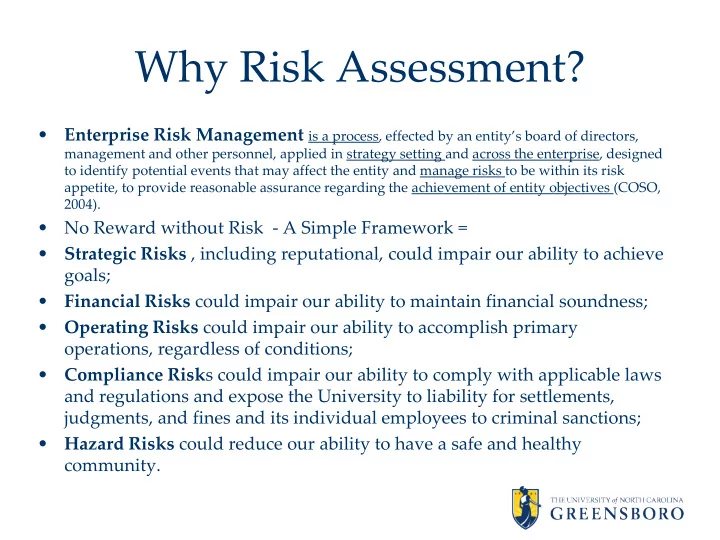

Why Risk Assessment? • Enterprise Risk Management is a process, effected by an entity’s board of directors, management and other personnel, applied in strategy setting and across the enterprise, designed to identify potential events that may affect the entity and manage risks to be within its risk appetite, to provide reasonable assurance regarding the achievement of entity objectives (COSO, 2004). • No Reward without Risk - A Simple Framework = • Strategic Risks , including reputational, could impair our ability to achieve goals; • Financial Risks could impair our ability to maintain financial soundness; • Operating Risks could impair our ability to accomplish primary operations, regardless of conditions; • Compliance Risk s could impair our ability to comply with applicable laws and regulations and expose the University to liability for settlements, judgments, and fines and its individual employees to criminal sanctions; • Hazard Risks could reduce our ability to have a safe and healthy community.
Risk Assessment Process 1. Clearly describe how the goal will be reached. 2.Create list of risks that could keep university from reaching the goal (the risks), Create the list with input from across the university (enterprise wide), – Categorize risks using framework, – Focus on Strategic Risks. – 3. Assess each risk: Select the frequency (likelihood) rating from 1 to 5, – And a severity (threat) rating from -1 to -5, – Multiply and map. – 4. Determine how to treat/ mitigate risk to create Risk Plan: Avoid, – Accept & Monitor, – Transfer, – Reduce the likelihood, – Reduce the severity. – 5. Complete the Risk Chart for inclusion with Report.
Find the Priority Risks • Place the risk score on the map. • The most severe risks will fall in the ‘Red Zone’, so focus here. • Treat/mitigate a priority risk using: – Avoidance, – Acceptance & Monitoring, – Reducing the Frequency, – Reducing the Severity, or – Transference.
Risk Chart
Recommend
More recommend